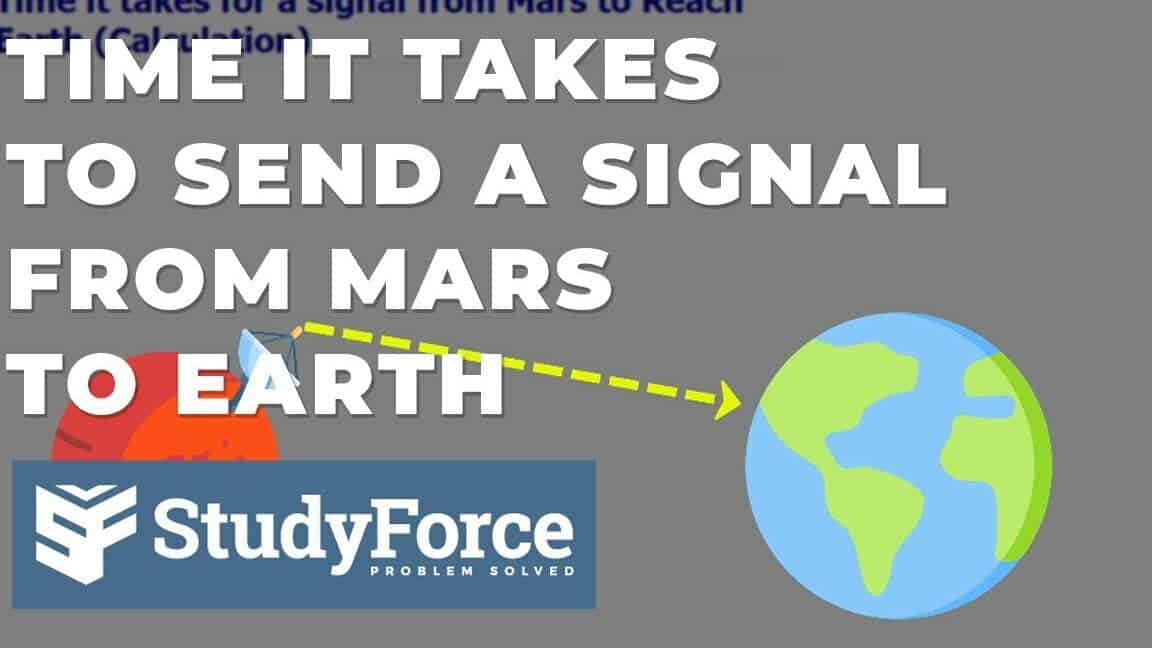
Transmitting Signals Between Mars and Earth
In order to establish radio communication, it is necessary to have at least two stations located at a specific distance: a transmitting station and a receiving station. The communication between Mars and Earth, as well as all communication between the two planets, occurs through the use of satellites.
On orbital modules such as Mars Odysseus, Mars Express, Mars Renaissance, and the Indian interplanetary station Mangalyan, communication with Mars was achieved through the use of highly directional antennas. This allowed for a connection to be established with Earth. Although the signal received on Earth was relatively weak, a network of ground stations was able to collect, amplify, and decode the data.
The Mars rovers transmitted data to the Mars Express and Mars Odysseus orbital stations, which then relayed it to Earth.
How signals are transmitted in a vacuum
The delay of radio signals is not dependent on the equipment used on Earth or the reception of signals in orbit around a smaller planet. This phenomenon is governed by a fundamental relativistic physical law that was formulated by Albert Einstein in 1905.
According to this law, the speed of electromagnetic radiation in a vacuum (including long and short radio waves, radiation, and infrared radiation) is equal to the speed of light, which is approximately 300,000 kilometers per second.
How much time does it take for a signal to reach Mars?
Controlling a spacecraft as it approaches or orbits Mars, and ensuring that it can communicate with Mars while taking into account the signal delay, is a complex process due to the large distance involved. Radio signals from Earth to Mars have a significant propagation time. During the Martian Research Laboratory (MHR) mission of the Mars rover Curiosity (named after its curious and inquisitive nature), the average delay in signal transmission was 13 minutes and 48 seconds. The minimum delay was 3 minutes, while the maximum delay was 24 minutes.
The variation in these values is because the distance between Earth and Mars is not constant. The planets follow elliptical orbits around the Sun, which means their distances from each other can change. The sizes of the planets also vary.
The maximum distance between the planets occurs when they are located on opposite sides of the Sun at their farthest orbital points, which amounts to a distance of 401,330,000 km. It takes 24 minutes for a signal to travel this distance.
The European Mission Control Center uses various types of recorded time, such as SCET (Spacecraft Event Time) and ERT (Earth Reception Time). The SCET represents the specific moment when an event takes place on the spacecraft.
The event time is calculated by adding the travel time of the directed beam to the speed of light in a vacuum (OWLT) at the time of signal transmission. This implies that the signal will be received by the spacecraft after this duration. Alternatively, this value can be determined by subtracting this duration from the value of the signal received by the Earth’s surface station, i.e. ERT. This indicates that the signal was transmitted from the spacecraft at that time. The second abbreviation corresponds to the moment when the signal was detected on Earth, which typically takes 13 minutes for the signal to reach a receiver from Mars.
Issues with Communication
The LOS, or Line of Sight, is the connection between the transmitting and receiving stations on Mars and Earth that allows for radio communication. This line is unobstructed when the planets are closest together, allowing signals to pass freely. However, as the planets orbit the Sun, there are times when the Sun aligns with this line, causing interference. This interference occurs when the Sun is positioned between the stations on both planets, disrupting communication.
This interference greatly impacts radio transmission, leading to significant signal delays and, in some cases, complete blockage of wave transmission for extended periods of time, which can last weeks or even months.
Solution routes
An alteration to the deep space communication network (DSN) may be necessary in order to ensure uninterrupted communication even during a comparison of two celestial bodies.
Therefore, in the design of complex space station communication systems, a singular communication link will not suffice. A constellation of satellites, space communication stations in orbit around Mars and Earth, is required for the extended and uninterrupted operation of the station. Three additional satellites positioned in gravitationally stable regions around the Sun can ensure continuous reception and transmission of data between Mars and Earth.
A groundbreaking form of communication is currently in development: the Laser Communication Relay Demonstration (LCRD). This pioneering technology represents a significant advancement in optical communication for both deep space and near-Earth applications.
Can Mars support life?
Following Earth, Mars stands out as the most potentially habitable planet in our solar system for a variety of reasons. One such reason is the presence of water in its soil, which could be extracted for use. Additionally, Mars experiences temperatures that are neither too cold nor too hot. Furthermore, the gravity on Mars is only 38% of that on Earth, leading many to believe that it could be suitable for human adaptation.
Is it possible for humans to travel at the speed of light?
Will humans ever have the capability to travel at the speed of light? According to our current knowledge of physics and the constraints of the natural world, the answer is regrettably no. … Therefore, traveling at or surpassing the speed of light is scientifically unattainable, particularly for objects with mass, like spaceships and individuals.
What is the maximum speed we can achieve in outer space?
According to Einstein’s theory, the speed of light in a vacuum is the ultimate speed limit in the universe. No object can travel faster than 300,000 kilometers per second (186,000 miles per second).
How much time does it take for light to travel from Earth to Mars?
With an average distance of 142 million miles, it takes approximately 12 minutes and 42 seconds for light to travel from Mars to Earth.
Has there ever been any existence of life on Mars?
So far, there has been no indication of any past or present existence of life on Mars. The combined evidence suggests that during the ancient Noah period, there existed liquid water on the Martian surface, and it could have been suitable for microbial life.
What is the period of extreme anxiety lasting for 7 minutes?
The phase of the Mars mission known as Entry, Descent, and Landing (EDL) is often called the “seven minutes of terror” because it is an intense and fast sequence that happens quicker than radio signals can travel from Mars to Earth.
In theory, the minimum distance between Earth and Mars occurs when Mars is at its closest point to the Sun (perihelion) and Earth is at its farthest point (aphelion). This will result in a separation of 33.9 million miles (54.6 million kilometers) between the two planets.
What is the duration of a journey to Mars?
The duration of the journey is approximately seven months, which is slightly longer than the time spent by astronauts on the International Space Station. The exact duration of each trip varies depending on when it is undertaken. Due to the elliptical nature of the orbits of Mars and Earth, the travel time can range from six to eight months.
What is the speed of satellites traveling to Mars?
When a spacecraft is launched from Earth, it travels at approximately 24,600 miles per hour (or roughly 39,600 kilometers per hour). This rapid speed allows the spacecraft to reach Mars in about seven months, covering a distance of approximately 480 million kilometers.
How do signals get transmitted from Mars to Earth?
In order to establish communication with Earth, Curiosity often utilizes its ultra-high frequency (UHF) antenna, which operates at around 400 megahertz. This antenna sends radio waves to Mars Odyssey and NASA’s Martian orbiters, enabling the transmission of data back to Earth at a faster rate.
How far can we travel in space?
If we were to define the boundary of the universe as the utmost object within our reach if we were to embark on our journey immediately, our current limitation would be a mere 18 billion light years. This accounts for a mere 6% of the total volume of our observable universe.
Which is nearer to the Sun, Earth or Mars?
As with all the planets in our solar system, both Earth and Mars orbit around the Sun. However, Earth is positioned closer to the Sun, resulting in a faster movement within its orbit.
Interplanetary Internet
The project called Interplanetary Internet aims to provide space stations with a highly advanced space Internet system. The development of this system is based on the innovative DTN (Delay / Disruption Tolerant Networking) protocol.
In space, signal disruptions are a common occurrence, but this protocol is capable of ensuring seamless transmission of large volumes of information even in the presence of failures and delays. When a transmitted data signal reaches a node where further transmission is not currently possible, it is stored. The system then actively searches for a communication channel and transmits the data when it becomes feasible to establish contact with the next node.
This project opens up the possibility of establishing and developing the Internet on Mars in the future, enabling Martian research stations to establish Wi-Fi connections.
Information data is transmitted between Mars and Earth through signals at different speeds and levels of stability. As time goes on, the number of satellites and orbital stations is increasing, which requires higher-quality equipment for space exploration.
Determining the initial velocity needed to reach Mars is a relatively simple task that can be described by basic physics formulas. This velocity allows a spacecraft to lift off from the surface of the red planet and travel along its orbit. Developing these spacecraft is a crucial objective in projects focused on colonizing and exploring Mars.

Definition of primary and secondary space velocities.
In order for a rocket to enter outer space, it needs to be accelerated to a certain speed that can overcome the gravitational force of the Earth.
The primary space velocity refers to the speed that an object must maintain in order to stay in orbit, moving horizontally above the planet’s surface without descending into it and without deviating from its circular path.
On Earth, this velocity is 7.9 kilometers per second. On Mars, it is slightly lower at 3.53 kilometers per second, due to Mars having a mass almost twice that of Earth. The calculations for these velocities will be explained in more detail below.
However, when it comes to traveling between planets, simply putting an object into orbit is not sufficient. It is also necessary to provide the object with enough momentum to continue moving along a parabolic trajectory, disregarding the gravitational pull of the planet. This velocity is known as the second space velocity, and is often referred to as escape velocity or parabolic velocity.
The second space velocity is the minimum velocity required for an object to overcome the gravitational force of the central planet and break free from its closed orbit.
The specific values for the second space velocity on Mars and Earth are 5 km/s and 11.2 km/s, respectively.
The formulas for determining the two spatial velocities are derived from the fundamental principle of Newton’s classical theory of gravitation, which enables precise calculations of numerous parameters and properties of celestial bodies and star clusters.
Upon examination of the gravitational theory of objects, it is established that the attractive force between two objects is directly proportional to their masses and inversely proportional to the distance separating them.

The formula for gravitational force is represented by Fgr, where m1 and m2 are the masses of the interacting bodies, and r is the distance between them. The gravitational constant, G, plays a significant role in this equation.
Calculation of the initial and secondary space velocities
In order to calculate and determine the initial space velocity on Mars, we can utilize the equation of motion, also known as Newton’s second law:
For our specific scenario, F represents the gravitational force that keeps the celestial body in orbit, m represents the mass of the celestial body, and a represents its acceleration.
The acceleration of a celestial body moving in a circular path is centripetal and can be expressed as v^2/r, where v represents the initial space velocity. By substituting these values into the formula, we obtain:

The mass of Mars, denoted by M, can be determined by the gravitational constant, denoted by G, and the radius of the orbit, denoted by r.
By utilizing this equation, we can calculate:

By plugging in the mass of Mars and other relevant values into the equation, we can determine that the first escape velocity of Mars is roughly:
v1 = 3.5 m/s = 3.53 km/s = 12728 km/h = 2.2 miles/s = 7909 mph
Let’s proceed with the calculation for the second escape velocity on Mars. This value is derived from the law of conservation of energy, which explains the motion of a celestial body as it falls towards a planet from an infinite distance:

Here, r represents the radius of the planet, h represents the height of the object above the planet, M represents the mass of Mars, G represents the gravitational coefficient, and v represents the second space velocity.
The gravitational coefficient, G, has a small numerical value which means that the gravitational forces exerted by objects with small masses are not noticeable on our planet Earth. However, for massive astronomical bodies, gravity and its force are of utmost importance.
We can solve the equation to determine the value of v:

Therefore, based on the given Martian parameter values, we can calculate the second space velocity for Mars:
v2 = 5000 m/s = 18000 km/h = 5 km/s = 3.11 miles/s = 11185 mph
The ratio of the two space velocities is as follows:
By the way, if the velocity of a flying object has a horizontal direction and is greater than the first space velocity but less than the second space velocity, the object will move in an elliptical orbit.
The shapes of orbits along which flying objects move away from the planet can be categorized as conic sections:
- circle – for bodies with a velocity of 1;
- ellipse – for bodies with a velocity just below Mach 2;
- parabola – for bodies with a velocity at Mach 2;
- hyperbola – for bodies with a velocity greater than the second space velocity.
In school textbooks, there are numerous fascinating exercises on the subject of space. A significant portion of these exercises start with phrases like “determine the second velocity of a celestial body,” “compute the initial speed of a star,” or “derive an equation for estimating the velocity of a spacecraft orbiting Mars.”
The way to compute the necessary parameters and velocities is through solving these typical problems using the derived formulas.
Additional space velocities include the third, fourth, and fifth space velocities
In addition to the initial two cosmic velocities (v1, v2), there exist other concepts known as v3, v4, and v5. These space velocities represent the speeds of movement and characteristics of flying objects or vehicles within the gravitational fields of astronomical space, influenced by celestial bodies and systems such as satellites, asteroids, stars, comets, planets, galaxies, and star clusters.
Critical velocities in space are crucial for rockets and vehicles to break free from the strong gravitational pull and venture into the vastness of the Universe. These velocities have different outcomes:
- v1 – the object becomes a satellite of a celestial body, orbiting at a relatively low altitude above its surface;
- v2 – in this scenario, the spacecraft can overcome the force of gravity and move away from the planet;
- v3 – at such speeds, the spacecraft can escape not only the gravitational field of the planet but also the entire planetary system, like the Solar System, and break free from the gravitational pull of the central star;
- v4 – enables the spacecraft to exit an entire galaxy;
- v5, v6, etc. – a concept that can be described as something out of a science fiction realm, a velocity that enables one to traverse to any destination within any other galaxy and even the entire Universe, surpassing unprecedented gravitational forces.
The initial two velocities aid in the exploration of our solar system and its surrounding regions. However, they are evidently insufficient for unrestricted and rapid interstellar travel across the vast cosmic expanse that is gradually being unveiled to us. The time will arrive when additional super velocities will be accessible to humanity. Yet, achieving this necessitates the discovery of alternative sources of inexpensive energy, a feat that still lies beyond our current capabilities.
Did you find the information helpful? Show your approval on social media!
Imagine two planets that have the same day length but different year lengths. It’s like synchronized swimmers in space as they orbit around the Sun. No matter where they are in their orbits, the planets can still communicate with each other.
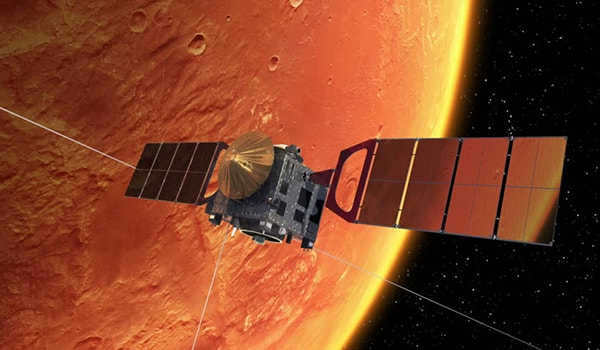
Transmitting Signals between Earth and Mars
In order for radio communication to happen, two stations are required – one for transmitting and one for receiving. When it comes to communication between Mars and Earth, this is achieved through the use of satellites.
Various orbital modules, including Mars Odyssey, Mars Express, Mars Renaissance, and the Indian interplanetary station Mangalyan, employ a high directional antenna to establish communication with Mars. These antennas are specifically tuned to Earth. While the signals received on Earth may be weak, a network of ground stations is able to capture, amplify, and decode the data.
Planeteers beamed data to the Mars Express and Mars Odyssey orbital stations, and the latter has already transmitted them back to Earth.
How signals are transmitted in a vacuum
The delay in radio signals is not due to the design of equipment on Earth or how signals are received on the orbit of a less massive planet. This phenomenon is connected to a fundamental physical law formulated by Albert Einstein in 1905, which states.
The speed of electromagnetic radiation in a vacuum (including long and short radio waves, radiation, infrared radiation, etc.) is equal to the speed of light, specifically 300,000 kilometers per second with a small margin of error.
How long does it take for a signal to reach Mars?
Managing a spacecraft as it approaches Mars’ orbit, or while it is in orbit, and maintaining communication with Mars, involves dealing with the time it takes for a signal to travel to Mars. The process is complex. Radio signals traveling from Earth to Mars take a considerable amount of time to propagate. During the operations of the Mars Science Laboratory (MSL) and its rover, Curiosity (named after its curious and inquisitive nature), the delay in signal transmission was measured to be 13 minutes and 48 seconds on average. However, the minimum and maximum values were 3 and 24 minutes, respectively.
The difference in these values is a result of the fact that the distance between Earth and Mars is not constant. The planets follow elliptical orbits around the Sun, causing their distances from each other to vary. Additionally, the diameters of the planets differ in magnitude.
At a distance of 54,550,000 km, Mars is closest to Earth. It takes 3 minutes for a communication signal, traveling at a speed of 300,000 km/s, to reach the receiver.
On the other hand, when the planets are at their farthest points from the Sun, which is 401,330,000 km, it takes 24 minutes for the signal to travel this distance.
The European Mission Control Center uses different types of recorded time. SCET (Spacecraft Event Time) represents the time when an event occurs on the spacecraft, while ERT (Earth Receive Time) represents the time when Earth receives the signal.
The event time is calculated by adding the time it takes for the guided beam to travel at the speed of light in a vacuum (OWLT) to the signal sending time. This results in the reception of the signal on the spacecraft after a certain time interval. Additionally, this value can be obtained by subtracting this interval from the received signal value from the Earth’s surface station, known as ERT. This indicates the time at which the signal was sent from the spacecraft. The second abbreviation represents the time at which the signal originated on Earth, which typically takes 13 minutes to reach the receiver on Mars.
Interruptions in Communication
The Line of Sight (LOS) is the connection between Earth and Mars, where the transmitting and receiving stations are located. It is responsible for transmitting radio communications. When the distance between the planets is at its minimum, there are no obstacles for the signals to pass through. However, as the planets move along their orbits, there are instances when the Sun aligns with this line. This alignment occurs between the stations on both planets and can disrupt communication.
This interference significantly affects the radio signal, causing a significant delay and, in some cases, completely blocking the transmission of waves for extended periods, which can last for weeks or even months.
Solutions
To ensure continuous communication, even during the encounter of two celestial bodies, it might be necessary to make modifications to the Deep Space Network (DSN).
Thus, when designing intricate systems of space communication stations, a singular communication link will not be adequate. A network of satellites and space communication stations orbiting both Mars and Earth is imperative for prolonged and uninterrupted station operation. By positioning three supplementary satellites in areas of gravitational stability around the Sun, constant data reception and transmission between Mars and Earth can be ensured.
A revolutionary method of signal transmission
A cutting-edge form of communication, known as Laser Communications Relay Demonstration (LCRD), is currently under development. This innovative optical communication system is specifically designed for use in both deep space missions and near-Earth systems.
The Future of Interplanetary Connectivity
The groundbreaking Interplanetary Internet project aims to establish an ultra long-range space internet infrastructure. This ambitious initiative is based on the innovative DTN (Delay/Disruption Tolerant Networking) protocol.
In outer space, signal transmission disruptions are a frequent occurrence, and the protocol ensures optimal information flow even in the presence of failures and delays. If transmission is not possible, the received data signal is recorded at the node, and the communication channel is then sought. Once communication with the next node becomes possible, the data is transmitted.
Thanks to this initiative, it may be possible for the Internet to be established and thrive on Mars in the future, enabling scientific Martian stations to have access to Wi-Fi connections.
Was the information helpful? Share it on social media!
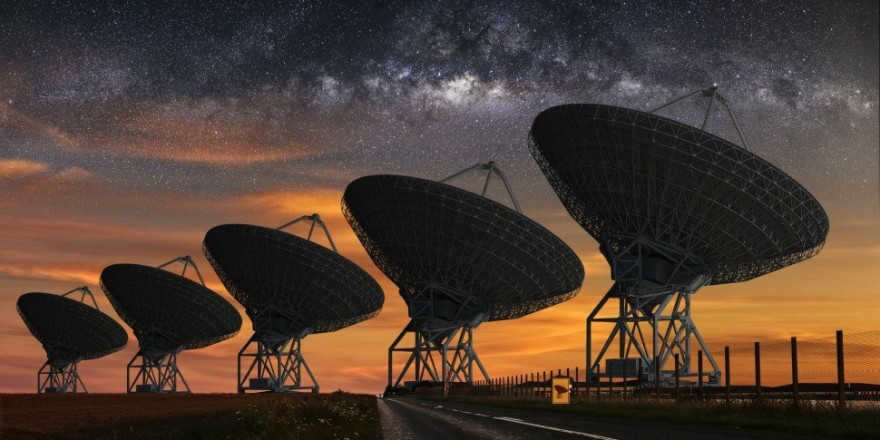
For a considerable amount of time, spaceships have been embarking on voyages to far-off planets within the solar system. In fact, a few Voyagers have successfully evaded into the heliopause. The question arises: how are we able to keep track of their whereabouts? The answer lies in the transmission of images and information through radio waves.
This is actually quite a complex communication system. It is vital to comprehend that due to the immense distance between objects, there is always a delay in signal transmission. Across the globe, there are expansive DSN radio antennas that receive signals from NASA spacecraft. The positioning of these antennas in various parts of the world is significant because as the planet rotates, the spacecraft always remain within sight.
Modern spacecraft that travel long distances strive to achieve a high level of autonomy. An example of this is the New Horizons spacecraft, which in early 2019 completed a flyby of 2014 MU69, a celestial object located 43.4 astronomical units away from the Sun! This distance is incredibly vast, which is why these spacecraft are equipped with special protocols to handle any potential critical situations.
When considering future human missions, communication delay becomes a crucial factor. As we venture towards Mars, we must acknowledge that there will be a significant delay in communication, which can be particularly perilous in critical situations. Let’s examine the time it takes for a signal to travel one way from Earth to the other planets in our solar system.
Mercury
Mercury is the smallest planet in our solar system, and it is also the closest to the Sun. It is named after the Roman god Mercury, who is often depicted as a messenger. With a diameter of just 4,879 kilometers, Mercury is only slightly larger than Earth’s moon. It has a very thin atmosphere, composed mainly of helium and traces of hydrogen, oxygen, and sodium. Mercury’s surface is heavily cratered and covered in a layer of fine dust. It has no moons or rings, and its surface temperature can reach extreme highs and lows due to its proximity to the Sun. Despite being the closest planet to the Sun, Mercury is not the hottest planet in our solar system. That title goes to Venus, which has a thick atmosphere that traps heat and creates a runaway greenhouse effect.

The distance between us and the Sun’s first planet is about 82-217 million kilometers (it is crucial to consider the shifting position on its orbit). As a result, it takes approximately 5-12 minutes for a signal to travel to Mercury and back.
Venus
can be rephrased as
The planet Venus
.

Mars is the second planet from the Sun and one of the nearest to us. The gap between the planets is about 38-261 million km (with an orbital path that is almost circular), and it takes approximately 3-14 minutes for a signal to travel between them.
Red Planet
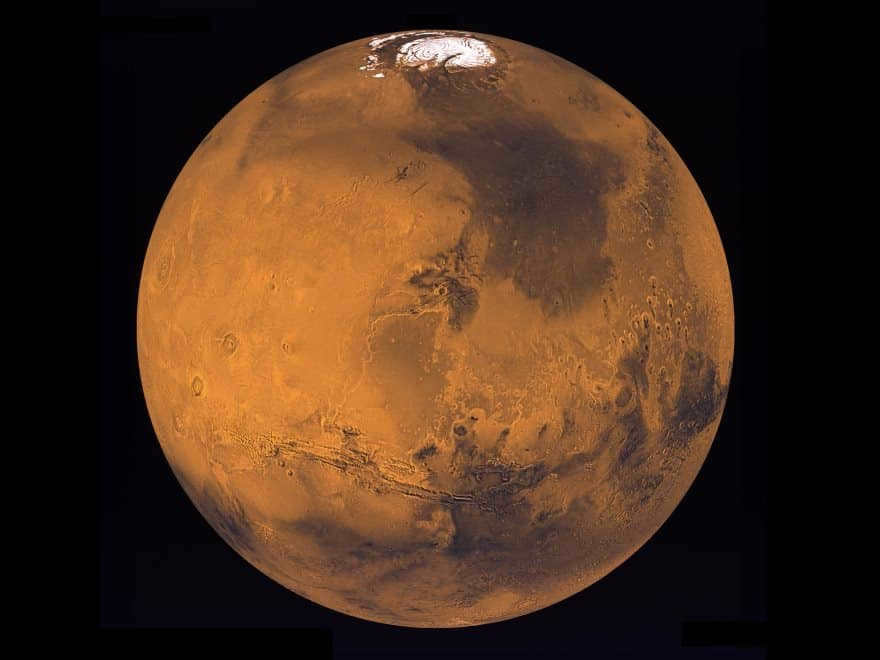
Mars is of great fascination to humanity, as it is on the verge of transforming into a fully established colony. The planet is located at a distance of 56-401 million kilometers from us, resulting in a signal delay of 4-20 minutes. Admittedly, this poses some inconvenience for communication between astronauts and the mission control, but we will need to find a way to adapt.
Jupiter
Jupiter is the largest planet in our solar system. It is a gas giant, made up mostly of hydrogen and helium. It is known for its distinctive red and white bands of clouds. Jupiter has a strong magnetic field and many moons. It is one of the brightest objects in the night sky and can often be seen with the naked eye.
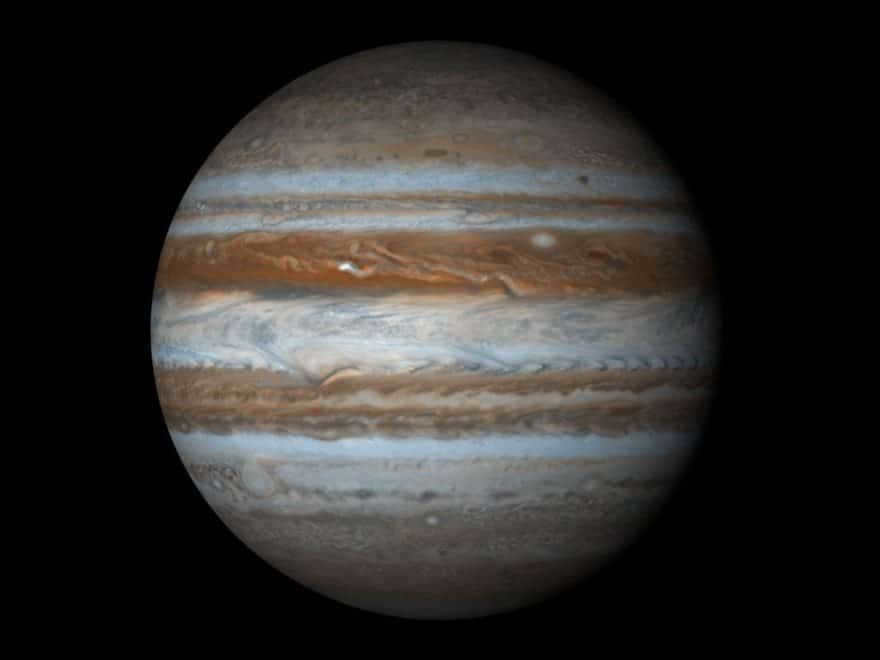
The solar system’s largest planet is positioned at a distance of 588-967 million kilometers. In addition, it takes approximately 35-52 minutes to receive a response.
Saturn
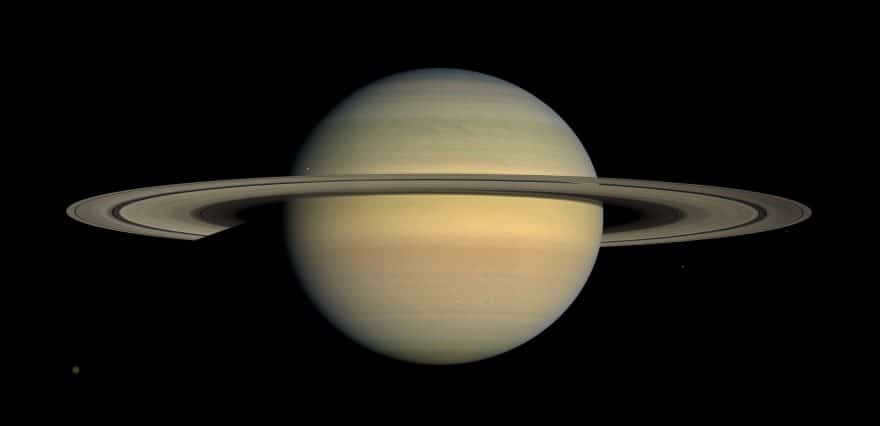
The ringed planet, Saturn, is located at a distance of 1195-1660 million kilometers from Earth. This vast distance causes a one-way signal delay of 71-88 minutes. It is worth noting that traveling to the gas giants themselves is highly unlikely for humanity. However, our focus lies on their moons, which means we must take into account the communication delay.
Uranus
Uranus is a planet in the solar system that is often referred to as the “ice giant.” It is the seventh planet from the sun and is known for its unique feature of rotating on its side. Uranus is composed mainly of hydrogen and helium, with traces of methane giving it its blue-green color. The planet has a system of rings and a total of 27 moons. Uranus is also famous for its extreme weather conditions, with winds reaching speeds of up to 560 miles per hour. Despite its intriguing characteristics, Uranus remains one of the least explored planets in our solar system.

The well-known phenomenon of the "planet tilted on its side" ("Uranus: The Mystery of its Unusual Tilt") is situated at a distance of 2.6 to 3.15 billion kilometers from our home planet. As a result, it takes approximately 152-168 minutes for a signal to travel to this far-off celestial body.

It is the final official planet on the roster, situated 4.3-4.6 billion kilometers away, with a signal velocity of 242-258 minutes.
P.S.
To clarify, if you manage to surpass Saturn, the response signal from Earthlings will require a delay of over two hours. Now, let’s envision the scenario with interstellar travel. Scientists will need to devise a method for achieving relatively prompt contact.
However, perhaps if we gain the ability to journey to neighboring stars, we will come up with something more advanced for communication? What are your thoughts?
So, what is the process of establishing communication with a rover situated on Mars? Consider this – even during Mars’ closest approach to Earth, the signal has to traverse a staggering distance of fifty-five million kilometers! That is an immense distance, no doubt. However, how does a solitary and diminutive rover succeed in transmitting its valuable scientific findings and breathtaking high-resolution images across such a vast expanse? In a nutshell, the basic concept can be illustrated as follows (I put in my best effort, honestly):
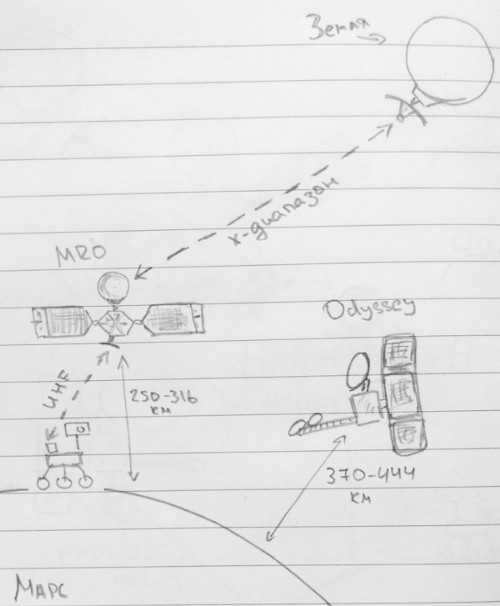
Therefore, the transmission of information typically involves three main entities – a space communication center located on our home planet, a satellite revolving around Mars, and the rover. Let’s begin with our beloved Earth and delve into the realm of DSN (Deep Space Network) space communication centers.
Space communication stations
NASA’s space missions are meticulously designed to maintain continuous communication with their spacecraft, ensuring a 24-hour link (or as close to it as technically feasible). Given the Earth’s rapid rotation, it becomes essential to establish multiple points for data transmission and reception. The Deep Space Network (DSN) stations serve precisely this purpose, strategically positioned across three continents and roughly 120 degrees of longitude apart. This strategic placement allows for partial overlapping of coverage areas, enabling seamless 24-hour guidance of the spacecraft. Whenever a spacecraft moves beyond the range of one station, its signal is seamlessly handed over to another station, ensuring uninterrupted communication.
There are three DSN complexes located around the world. The first one, known as the Goldstone complex, is situated in the United States. The second complex is located in Spain, approximately 60 kilometers away from Madrid. Lastly, the third complex is found in Australia, about 40 kilometers from Canberra.
Each complex has its own set of antennas, collectively known as DSS (Deep Space Stations). These antennas are numbered according to their location. The antennas in the United States are labeled 1X-2X, while the ones in Australia are labeled 3X-4X. As for the antennas in Spain, they are labeled 5X-6X. For instance, if you hear the term “DSS53,” you can be certain that it refers to one of the Spanish antennas.
When it comes to communicating with Mars rovers, the complex in Canberra is the most frequently used. Therefore, let’s delve a little deeper into this particular complex.
Currently, the station in Canberra is equipped with three active antennas: DSS-34 (with a diameter of 34 meters), DSS-43 (an impressive 70 meters in diameter), and DSS-45 (also 34 meters in diameter). Over the years, the center has utilized other antennas that have been taken out of service for various reasons. For instance, the original antenna, DSS42, was decommissioned in December 2000, and the 11-meter diameter antenna, DSS33, was decommissioned in February 2002. In 2009, DSS33 was relocated to Norway to continue its scientific work as an atmospheric instrument.
The initial working antenna mentioned, DSS34, was constructed in 1997 and became the inaugural representative of the new generation of these devices. Its distinct characteristic is that the equipment for receiving/transmitting and signal processing is not directly located on the dish, but rather in the room beneath it. This design choice allowed for significant weight reduction of the dish and also enabled equipment servicing without interrupting antenna operation. DSS34 functions as an antenna-reflector, and its operational scheme is depicted below:
As depicted, there exists a chamber beneath the antenna where all the received signal processing occurs. In reality, this chamber is situated underground, hence it is not visible in the photographs.
- X-band (7145-7190 MHz)
- S-band (2025-2120 MHz)
- X-band (8400-8500 MHz)
- S-band (2200-2300 MHz)
- Ka-band (31.8-32.3 GHz)
- Accuracy of sky pointing within 0.015 degrees
- Accuracy of moving the antenna itself within 0.25mm
- Antenna speed: 2.0 degrees per second
- Can withstand constant wind speeds of 72km/h
- Can withstand gusts of up to 88km/h
- Maximum design speed is 160km/h
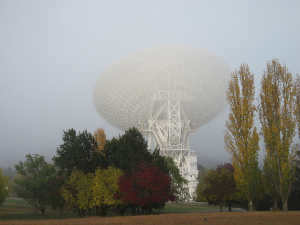
DSS43 (which is approaching its anniversary) is an older model that was constructed between 1969 and 1973 and upgraded in 1987. DSS43 stands as the largest movable parabolic antenna in the southern hemisphere of our planet. The immense structure, weighing over 3,000 tons, is rotated on a film of oil approximately 0.17 millimeters thick. The dish’s surface is composed of 1272 aluminum panels and spans an area of 4180 square meters.
DSS43, click-worthy
- X-band (7145-7190 MHz)
- S-band (2025-2120 MHz)
- X-band (8400-8500 MHz)
- S-band (2200-2300 MHz)
- L-band (1626-1708 MHz)
- K-band (12.5 GHz)
- Ku-band (18-26 GHz)
- within 0.005° (sky pointing accuracy)
- Accuracy of moving the antenna itself is within 0.25mm
- Angular velocity is 0.25°/sec.
- Constant wind speed is 72km/h
- Gusts reach up to 88km/h
- Maximum design wind speed is 160km/h
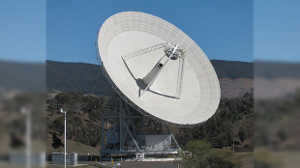
DSS45. This antenna was constructed in 1986 with the original purpose of facilitating communication with Voyager 2 while it was studying Uranus. It is capable of rotating on a circular base that measures 19.6 meters in diameter. The rotation is made possible by 4 wheels, two of which function as drive wheels.
DSS45, clickable
- X-band (7145-7190 MHz)
- X-band (8400-8500 MHz)
- S-band (2200-2300 MHz)
- within 0.015° (sky pointing accuracy)
- Within 0.25mm (accuracy of moving the antenna itself)
- 0.8°/sec.
- Constant wind 72km/h
- Gusts +88km/h
- Maximum design – 160km/h
If we discuss the space communication station as a whole, there are four key tasks that it must accomplish:
Telemetry – Receiving, decoding, and processing telemetry data from spacecraft. Typically, these data consist of scientific and engineering information transmitted via a radio channel. The telemetry system receives the data, monitors its changes and compliance, and transmits it to validation systems or scientific centers for processing.
Tracking – The tracking system must facilitate two-way communication between Earth and the spacecraft, as well as calculate its position and velocity vector to accurately position the teeter-totter.
Control – Allows specialists to transmit control commands to the spacecraft.
Monitoring and control – Enable the monitoring and control of the DSN’s own systems.
It is important to acknowledge that the current scope of the Australian station includes approximately 45 spacecraft, resulting in a well-regulated work schedule that does not allow for much flexibility. Additionally, each antenna possesses the technical capacity to accommodate two different spacecraft simultaneously.
Consequently, data destined for the rover is transmitted to the DSN station, which serves as the starting point for its brief (5 to 20 minutes) voyage through space to reach the Red Planet. Now, let us delve into the rover’s communication capabilities.
Curiosity
Curiosity has three antennas that can both receive and transmit information. These antennas are located on the “back” of the rover in different positions. They include a UHF antenna, an LGA, and an HGA.[1]
[1]
HGA – High Gain Antenna
MGA – Medium Gain Antenna
LGA – Low Gain Antenna
UHF – Ultra High Frequency
Since the abbreviations HGA, MGA, and LGA already contain the word “antenna,” I will not repeat this word for them, unlike the abbreviation UHF.
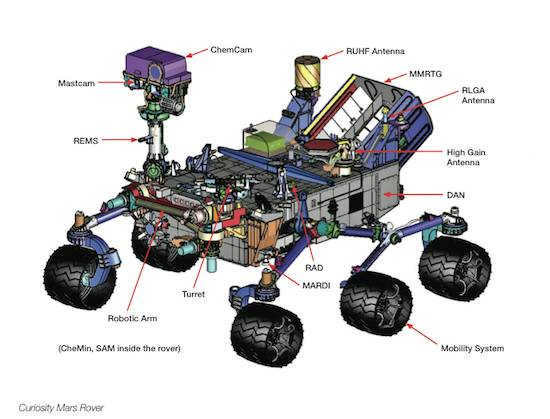
Our focus lies in RUHF, RLGA, and the High Gain Antenna
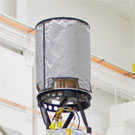
The UHF antenna is the most commonly used one. It enables the rover to transmit data via the MRO and Odyssey satellites (which we will discuss further) at a frequency of approximately 400 megahertz. The use of satellites for signal transmission is preferred because they remain within the field of view of DSN-stations for a much longer time than the rover, which is alone on the surface of Mars. Furthermore, as they are much closer to the rover, the latter requires less energy to transmit data. The transmission speeds can reach up to 256kbps for Odyssey and up to 2 mbps for MRO. Most of Curiosity’s data is received through the MRO satellite. The UHF antenna itself is situated at the back of the rover and appears as a grey cylinder.
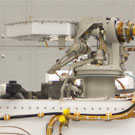
Curiosity rover also possesses a High Gain Antenna (HGA) that enables it to directly receive commands from Earth. This antenna has the ability to move and be directed towards Earth, allowing the rover to conserve energy by not having to change its position. The HGA is positioned in the middle on the left side of the rover and has a hexagonal shape with a diameter of approximately 30 centimeters. It is capable of transmitting data directly to Earth at a speed of around 160 bps when connected to the 34-meter antennas, and up to 800 bps when connected to the 70-meter antennas.

Lastly, the third antenna is known as the LGA antenna. This particular antenna has the ability to transmit and receive signals in all directions. The LGA operates within the X-band frequency range, specifically between 7 to 8 GHz. However, it should be noted that the power of this antenna is relatively low, and its transmission speed is not particularly impressive. As a result, it is primarily used for receiving information rather than transmitting it. In the accompanying photo, the LGA antenna is represented by the white tower located in the foreground. The UHF antenna can be spotted in the background.
It should be highlighted that the rover produces an immense quantity of scientific data, and it is not always feasible to transmit all of it. NASA experts establish prioritization: data with the utmost priority will be transmitted first, while data with lower priority will be deferred until the next communication opportunity. Occasionally, even some of the least significant data has to be discarded.
Therefore, it has been discovered that typically, in order to communicate with Curiosity, it is necessary to utilize an “intermediate link” in the form of one of the satellites. This results in an increase in both the duration of communication with Curiosity and the speed of data transmission. This is due to the fact that the satellites possess more powerful antennas, enabling them to transmit data back to Earth at a significantly higher rate.
Each of the satellites offers two communication windows with the rover per sol. These windows are usually of a relatively short duration, lasting only a few minutes. In the event of an emergency, Curiosity also has the capability to establish contact with the Mars Express Orbiter satellite, which is operated by the European Space Agency.
Mars Odyssey Mission
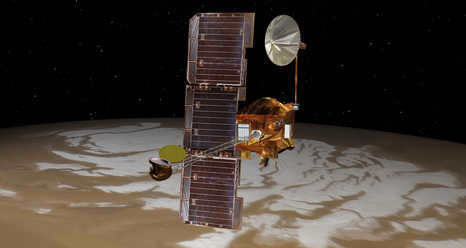
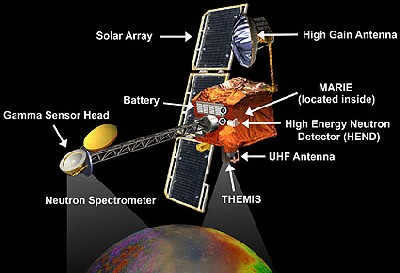
The instruments of the satellite are positioned in different locations.
For communication with the rovers, a UHF antenna is used at frequencies of 437 MHz for transmission and 401 MHz for reception. The data rate can vary at 8, 32, 128, or 256 kb/sec.
The Mars Reconnaissance Orbiter
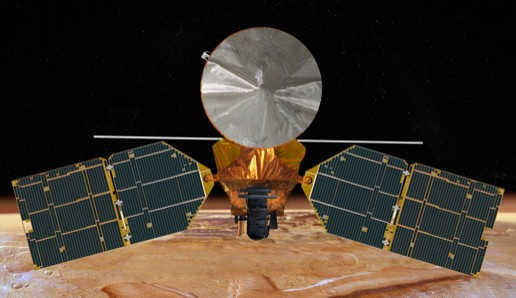
The signal from Mars to Earth takes how long?

My proposal is for the most observant individuals to locate the Opportunity rover in the given image 😉
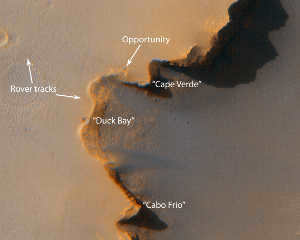
Please take note that the majority of the color images are captured in the extended range. So, if you happen to come across an image where a certain part of the surface appears bright blue-greenish, there’s no need to jump to any conspiracy theories 😉 Rest assured that the same rocks will exhibit the same color in various pictures. Now, let’s shift our focus back to the communication systems.
MRO is equipped with four antennas, which serve the same purpose as the rover’s antennas. These include a UHF antenna, an HGA, and two LGAs. The primary antenna utilized by the satellite, known as HGA, boasts a three-meter diameter and operates in the X-band. It is responsible for transmitting data back to Earth. Furthermore, the HGA is equipped with a 100-watt signal amplifier.
1 – HGA, 3 – UHF, 10 – LGA (both LGAs are directly mounted on the HGA)
Communication between Curiosity and MRO is facilitated through the utilization of the UHF antenna. The communication window is available twice per sol, with each session lasting around 6-9 minutes. MRO designates 5GB of storage per day for rover data, which is retained until it comes within range of one of the DSN stations on Earth. At that point, the data is transmitted to the designated station. The process of transmitting data to the rover operates on the same principle. In this case, 30 MB/sol is allocated for the storage of commands intended for transmission to the rover.
DSN stations carry out maintenance, repair, and operations (MRO) activities for 16 hours daily. During the remaining 8 hours, the satellite is positioned on the far side of Mars, making it unable to exchange data due to the obstruction caused by the planet. Out of the 16 operational hours, the satellite transmits data to Earth for approximately 10-11 hours. Typically, the satellite utilizes a 70-meter DSN antenna for three days each week, while twice a week it employs a 34-meter antenna. However, it remains unclear what activities take place during the remaining two days, although it is unlikely that the satellite has weekends. The transmission rates can range from 0.5 to 4 megabits per second. The rates decrease as the distance between Mars and Earth increases, while they increase as the two planets come closer together. Currently, Earth and Mars are at their farthest distance from each other, implying that the transmission rate is probably not very high at the time of writing this article.
Conclusion
- Commands are sent by JPL specialists to one of the DSN stations.
- During a communication session with one of the satellites (most likely MRO), a set of commands is sent by the DSN station to it.
- The satellite stores the data in its internal memory and waits for the next communication window with the rover.
- When the rover is within range, control commands are transmitted to it by the satellite.
- The rover stores its science data in internal memory and waits for the next communication window with the satellite.
- When the satellite becomes available, information is transmitted to it by the rover.
- The data is received by the satellite, stored in its memory, and waits for one of the DSN stations to become available.

